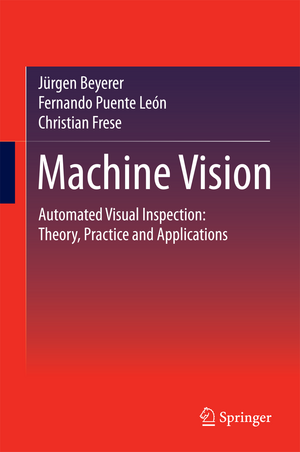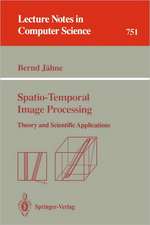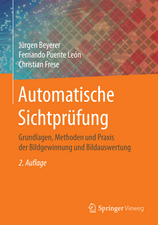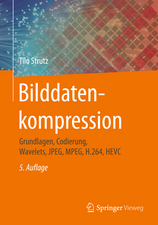Machine Vision: Automated Visual Inspection: Theory, Practice and Applications
Autor Jürgen Beyerer, Fernando Puente León, Christian Freseen Limba Engleză Hardback – 5 oct 2015
The second part deals with the modeling and processing of image signals and pays particular regard to methods, which are relevant for automated visual inspection.
| Toate formatele și edițiile | Preț | Express |
|---|---|---|
| Paperback (1) | 969.13 lei 6-8 săpt. | |
| Springer Berlin, Heidelberg – 23 aug 2016 | 969.13 lei 6-8 săpt. | |
| Hardback (1) | 1198.39 lei 38-45 zile | |
| Springer Berlin, Heidelberg – 5 oct 2015 | 1198.39 lei 38-45 zile |
Preț: 1198.39 lei
Preț vechi: 1556.34 lei
-23% Nou
Puncte Express: 1798
Preț estimativ în valută:
229.31€ • 239.42$ • 189.78£
229.31€ • 239.42$ • 189.78£
Carte tipărită la comandă
Livrare economică 31 martie-07 aprilie
Preluare comenzi: 021 569.72.76
Specificații
ISBN-13: 9783662477939
ISBN-10: 3662477939
Pagini: 850
Ilustrații: XX, 798 p.
Dimensiuni: 155 x 235 x 40 mm
Greutate: 1.68 kg
Ediția:1st ed. 2016
Editura: Springer Berlin, Heidelberg
Colecția Springer
Locul publicării:Berlin, Heidelberg, Germany
ISBN-10: 3662477939
Pagini: 850
Ilustrații: XX, 798 p.
Dimensiuni: 155 x 235 x 40 mm
Greutate: 1.68 kg
Ediția:1st ed. 2016
Editura: Springer Berlin, Heidelberg
Colecția Springer
Locul publicării:Berlin, Heidelberg, Germany
Public țintă
Professional/practitionerCuprins
Introduction.- Part I Image Acquisition: Light.- Optical Imaging.- Radiometry.- Color.- Sensors for Image Acquisition.- Methods for Image Acquisition.- Part II Image Processing: Image Signals.- Preprocessing and Image Enhancement.- Image Restoration.- Segmentation.- Morphological Image Processing.- Texture Analysis.- Detection.- Image Pyramids, Wavelet Transform and Multiresolution Analysis.- Mathematical Foundations.- The Fourier Transform.
Notă biografică
Prof. Dr.-Ing. habil. Jürgen Beyerer received his doctoral degree in 1994 by working in the field of image processing and especially in the subject of texture analysis. He habilitated in 1994 in the field of measurement technology and ran a small business for five years, which developed innovative automated visual inspection systems for industrial applications. Since 2004, Prof. Beyerer is the director of the Fraunhofer Institute of Optronics, System Technologies and Image Exploitation in Karlsruhe, which is mainly focused on the field of image processing. Simultaneously, he is holding the chair `Vision and Fusion Laboratory’ at the Karlsruhe Institute of Technology (KIT) which performs research in the fields of image acquisition and image processing.
Prof. Dr.-Ing. Fernando Puente León: received the Dipl.-Ing. degree in electrical engineering and the Ph.D. degree with a thesis on machine vision from the University of Karlsruhe, Germany, in 1994 and 1999, respectively. From 2001 to 2002, he was with the
company DS2, Spain. In 2003, he became a full professor at the Department of Electrical Engineering and Information Technology of the Technical University of Munich, Germany. Since 2008, he is a professor with the Department of Electrical Engineering and Information Technology of Karlsruhe Institute of Technology, where he also heads the Institute of Industrial Information Technology. His research interests include image processing, machine vision, information fusion, measurement technology, and pattern
recognition.
Dr.-Ing. Christian Frese has been engaged in the field of computer vision and image processing since 2005. He has been actively participating in several research projects concerned with multi-view stereo reconstruction, range image processing, image fusion,
feature extraction and image-based classification. He co-authored more than 25 scientific publications related to cognitive automobiles, robotics, and image
processing.
Prof. Dr.-Ing. Fernando Puente León: received the Dipl.-Ing. degree in electrical engineering and the Ph.D. degree with a thesis on machine vision from the University of Karlsruhe, Germany, in 1994 and 1999, respectively. From 2001 to 2002, he was with the
company DS2, Spain. In 2003, he became a full professor at the Department of Electrical Engineering and Information Technology of the Technical University of Munich, Germany. Since 2008, he is a professor with the Department of Electrical Engineering and Information Technology of Karlsruhe Institute of Technology, where he also heads the Institute of Industrial Information Technology. His research interests include image processing, machine vision, information fusion, measurement technology, and pattern
recognition.
Dr.-Ing. Christian Frese has been engaged in the field of computer vision and image processing since 2005. He has been actively participating in several research projects concerned with multi-view stereo reconstruction, range image processing, image fusion,
feature extraction and image-based classification. He co-authored more than 25 scientific publications related to cognitive automobiles, robotics, and image
processing.
Textul de pe ultima copertă
The book offers a thorough introduction to machine vision. It is organized in two parts. The first part covers the image acquisition, which is the crucial component of most automated visual inspection systems. All important methods are described in great detail and are presented with a reasoned structure.
The second part deals with the modeling and processing of image signals and pays particular regard to methods, which are relevant for automated visual inspection.
The second part deals with the modeling and processing of image signals and pays particular regard to methods, which are relevant for automated visual inspection.
Caracteristici
The reader is supposed to get a thorough understanding of the interaction of the presented methods All relevant conclusions are provided with at least a sketch of proof The reader will be provided with the “big picture” of the field




















